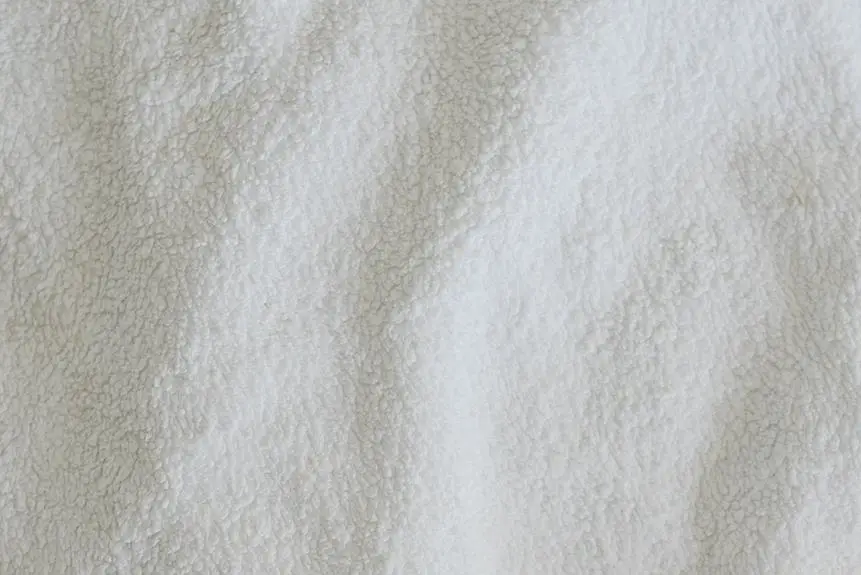If you've ever worn a French terry sweatshirt on a chilly day and marveled at its warmth, you might be wondering if it's the warmest fabric out there. French terry is indeed known for its excellent insulating properties, making it a popular choice for cozy loungewear and activewear.
In this guide, we'll explore the factors that contribute to French terry's warmth, compare it with other fabrics, and provide tips for maximizing its insulation. By the end, you'll have a clear understanding of whether French terry deserves its reputation as one of the warmest fabrics available.
So, let's dive in and unravel the mystery of French terry's warmth!
Key Takeaways
- French terry fabric has a unique construction with uncut loops on one side and a flat surface on the other.
- French terry is known for its excellent insulation and heat retention properties.
- The looped underside of French terry creates tiny air pockets that trap heat close to the body.
- French terry is versatile for layering and provides warmth without adding bulk.
Understanding French Terry Fabric
French terry fabric provides warmth and comfort due to its unique looped interior and soft, absorbent exterior. The construction of French terry involves weaving the fabric with uncut loops on one side, while the other side remains flat, creating a plush texture. This unique construction not only enhances the fabric's insulating properties but also ensures breathability. The looped interior allows air to circulate, making it an ideal choice for activewear and loungewear. The fabric's breathability prevents overheating during physical activities while still providing the necessary warmth in cooler temperatures.
French terry's ability to keep you warm without causing you to overheat is due to its fabric breathability. The interlocking weave of the fabric creates tiny openings that allow air to flow through, preventing the buildup of moisture and heat. This breathability makes French terry an excellent choice for various clothing items, from sweatshirts to jackets. Understanding the construction and fabric breathability of French terry allows you to appreciate its ability to provide both warmth and comfort in diverse settings.
Insulating Properties of French Terry
If you're wondering about the insulating properties of French terry, you'll be pleased to know that this fabric is known for its excellent insulation. French terry has the ability to retain heat, making it a great choice for keeping you warm in cooler temperatures.
The thermal benefits of French terry make it a popular choice for activewear and outerwear.
French Terry Insulates Well
Achieving warmth without bulk, layering French terry clothing can provide effective insulation in cold weather. French terry is known for its exceptional insulating properties, which can help regulate your body temperature in chilly conditions.
The fabric's looped underside creates tiny air pockets that trap heat close to your body, keeping you warm without the need for heavy layers. This thermal regulation is further enhanced by French terry's breathability, allowing excess heat and moisture to escape while retaining warmth.
Whether you're engaging in outdoor activities or simply navigating a cold climate, the insulating qualities of French terry make it an excellent choice for staying cozy without feeling weighed down.
Heat Retention in Terry
Layering French terry clothing allows you to experience effective heat retention in cold weather, as its looped underside creates tiny air pockets that trap heat close to your body. Additionally, the moisture-wicking properties of terry fabric help regulate your body temperature by keeping you dry and comfortable. This combination makes French terry an excellent choice for maintaining warmth in chilly conditions.
| Heat Retention | Moisture Wicking | Cold Weather |
|---|---|---|
| Traps heat close to the body | Regulates body temperature | Ideal for maintaining warmth |
Thermal Benefits of Terry
To experience the insulating properties of French terry, layer it over your clothing to effectively trap heat close to your body in cold weather. French terry fabric offers excellent thermal regulation, making it a great choice for staying warm in chilly conditions. Here's why it's so effective:
- Air Trapping: The looped pile construction of French terry creates tiny air pockets that act as insulators, keeping warmth close to your skin.
- Moisture Wicking: The fabric's breathability allows moisture to escape, preventing you from feeling clammy and cold.
- Versatile Layering: French terry's ability to provide warmth without adding bulk makes it ideal for layering under jackets or over base layers.
- Comfortable Insulation: Unlike some synthetic materials, French terry provides warmth while remaining soft and comfortable against your skin.
Comparison With Other Warm Fabrics
When comparing French Terry with other warm fabrics, you'll find that it excels in both insulation and comfort. To illustrate this further, let's compare French Terry with other popular warm fabrics. Below is a comparison table to provide a clear visual representation of the thermal conductivity, moisture-wicking capabilities, and layering techniques for French Terry and other warm fabrics.
| Fabric | Thermal Conductivity | Moisture Wicking | Layering Techniques |
|---|---|---|---|
| French Terry | Low | High | Excellent |
| Wool | High | Low | Good |
| Fleece | Low | High | Good |
| Flannel | Medium | Medium | Fair |
As seen in the table, French Terry stands out with low thermal conductivity, high moisture-wicking capabilities, and excellent layering techniques. This combination makes it an exceptional choice for staying warm and comfortable. While wool and fleece also provide good insulation, they may lack the moisture-wicking properties of French Terry. Flannel, on the other hand, offers fair insulation and moisture-wicking but doesn't match French Terry in terms of overall performance.
Factors Affecting Fabric Warmth
When it comes to the warmth of a fabric, there are several factors that come into play.
Fabric density, the insulating properties of the fibers, and the fabric's breathability all contribute to how warm it feels when you wear it.
Understanding these factors can help you choose the warmest fabric for your needs.
Fabric Density and Warmth
You can determine a fabric's warmth by considering its density and how tightly woven the fibers are. When it comes to fabric density and warmth, there are several factors to keep in mind:
- Fiber Thickness: Thicker fibers generally contribute to a denser fabric, providing better insulation and warmth.
- Weave Type: Fabrics with tight weaves, such as twill or satin weaves, tend to be denser and therefore offer more warmth.
- Fabric Weight: Heavier fabrics often have higher density, which can result in better insulation and warmth.
- Fiber Type: Natural fibers like wool and cashmere are inherently dense and provide excellent warmth due to their natural crimp and ability to trap air.
Understanding these factors can help you choose fabrics with the right density for optimal warmth.
Insulating Properties of Fibers
Exploring the insulating properties of fibers reveals essential factors affecting fabric warmth.
Insulating materials play a critical role in determining the warmth of a fabric. The ability of a material to trap heat and prevent its escape is essential for creating warm and cozy apparel.
Thermal conductivity, or the material's ability to conduct heat, is a key factor in determining its insulating properties. Fabrics with low thermal conductivity are more effective at retaining body heat, making them warmer to wear.
Additionally, the structure and composition of fibers also impact their insulating properties. For instance, natural fibers like wool and down feathers are known for their excellent insulation due to their unique structures.
Understanding these factors can help you choose the warmest fabric for your specific needs.
Breathability and Thermal Regulation
For achieving optimal warmth in your clothing, it's essential to consider the breathability and thermal regulation of the fabric. When it comes to fabric selection, understanding the breathability and thermal regulation of a fabric is crucial in determining its warmth.
Here are some factors that affect fabric warmth:
- Breathability: Look for fabrics that allow moisture and excess heat to escape, preventing you from feeling clammy and uncomfortable.
- Thermal Regulation: Fabrics that provide thermal regulation help maintain a comfortable body temperature by trapping heat when it's cold and releasing it when it's warm.
- Fabric Weight: Lighter-weight fabrics often offer better breathability, while heavier fabrics may provide increased insulation.
- Construction: Consider the weave or knit of the fabric, as this can impact breathability and thermal regulation.
These factors play a significant role in determining the warmth of a fabric, so keep them in mind when choosing the right material for your clothing.
Tips for Maximizing French Terry's Warmth
To maximize the warmth of French terry, layering with a form-fitting long-sleeve shirt underneath can enhance its insulating properties. The snug fit of the underlayer creates a barrier that traps heat close to your body, while the French terry fabric acts as a cozy outer layer. This combination helps to create a pocket of warm air between the layers, effectively maximizing the fabric's warmth.
Another tip for maximizing the warmth of French terry is to choose garments with a higher fabric weight. Look for French terry pieces that are made from thicker, heavier material as they tend to provide better insulation. Additionally, opting for styles with features like mock necks or hoods can offer extra protection against chilly winds and further enhance the warmth provided by the fabric.
When layering with French terry, it's also important to ensure that the outer layers are windproof to prevent cold air from penetrating through the fabric. This will help to maintain the warmth generated by the French terry and the underlayer.
Care and Maintenance for French Terry
To maintain the quality and longevity of your French terry garments, regularly wash them inside out in cold water and avoid using fabric softeners. This will help preserve the fabric's durability and prevent pilling or damage.
When drying your French terry items, opt for a low heat setting or air-dry them to prevent shrinkage and maintain their shape. High heat can cause the fabric to lose its softness and elasticity over time.
Avoid using bleach or harsh chemicals when cleaning your French terry garments, as these can weaken the fabric fibers and cause discoloration. Instead, opt for gentle, mild detergents that are specifically designed for delicate fabrics.
To prevent snags and pulls, it's important to avoid washing your French terry items with items that have zippers, hooks, or rough textures. These can cause damage to the fabric and affect its overall longevity.
Conclusion: Is French Terry the Warmest?
As you consider the warmth of French Terry, it's evident that its unique construction and insulating properties make it a top contender for cold-weather apparel. When comparing French Terry to fleece, both fabrics offer excellent warmth and insulation. However, French Terry's looped, moisture-wicking construction provides better breathability compared to the denser structure of fleece, making it a great option for thermal clothing.
French Terry's ability to trap heat while allowing moisture to escape makes it an ideal choice for staying warm and comfortable in various cold-weather activities.
In conclusion, while French Terry and fleece both offer warmth, French Terry's breathability and moisture-wicking properties set it apart, making it a versatile and effective option for thermal clothing. The decision between French Terry and fleece ultimately depends on personal preferences and the specific activities in which the clothing will be used.
As you explore thermal clothing options, consider the unique benefits of French Terry and how they align with your cold-weather needs.
Frequently Asked Questions
Can French Terry Fabric Be Used for Outdoor Activities in Extreme Cold Weather?
For outdoor activities in extreme cold weather, French terry fabric can be used as part of a layering system for insulation. It provides warmth and breathability, making it suitable for cold-weather pursuits. Follow specific washing instructions to maintain its effectiveness.
Are There Any Specific Washing Instructions for Maintaining the Insulating Properties of French Terry Fabric?
To maintain the insulating properties of French terry fabric, follow specific washing instructions. Use cold water, gentle cycle, and avoid harsh detergents. This helps preserve its temperature regulation and fabric durability, ensuring long-lasting warmth.
How Does French Terry Fabric Compare to Wool in Terms of Warmth and Insulation?
French terry is a versatile fabric known for its comfort and breathability. When comparing it to wool, French terry is generally lighter and less insulating, making it suitable for milder climates or indoor wear.
Can French Terry Fabric Be Layered With Other Materials for Added Warmth?
You can enhance the warmth of French terry fabric by layering it with other materials. Consider pairing it with insulating fabrics like fleece or wool for added warmth. Layering options provide versatile insulation techniques for staying cozy.
Are There Any Environmental Factors That Can Affect the Warmth of French Terry Fabric, Such as Humidity or Wind?
Humidity can impact the warmth of French terry fabric by affecting its breathability. Additionally, wind resistance plays a role in retaining body heat. Considering these factors, French terry provides warmth but may be influenced by environmental conditions.
- Why Is Red Velvet Not Red? - April 25, 2024
- How Do You Describe Velvet Fabric? - April 25, 2024
- How Strong Is Velvet? - April 25, 2024





